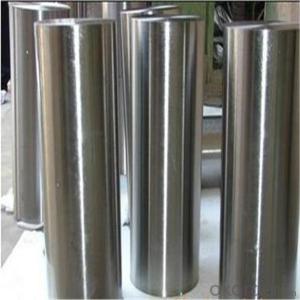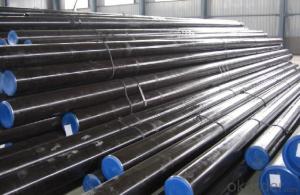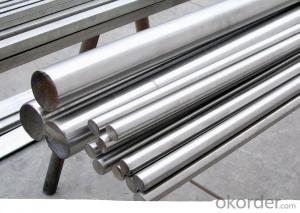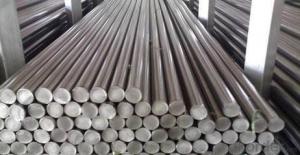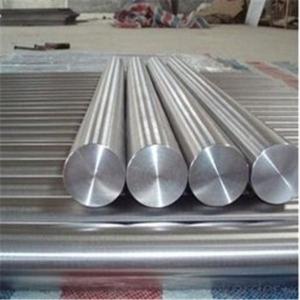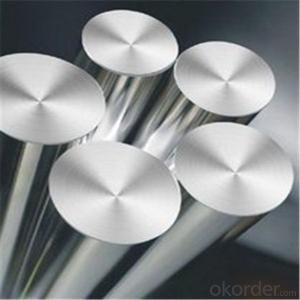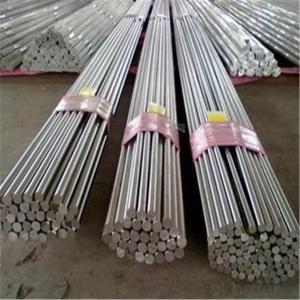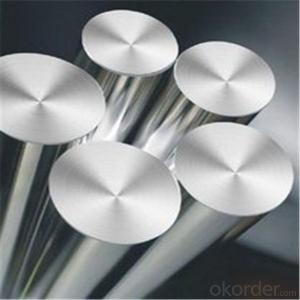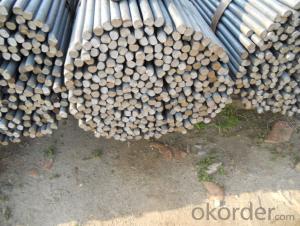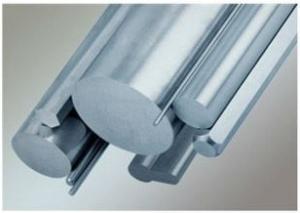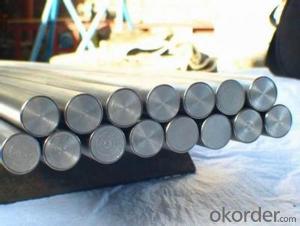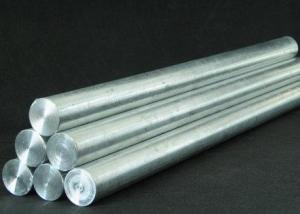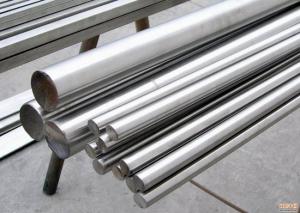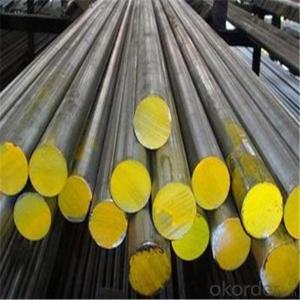Stainless Steel Round Bar Price Per KG in Wuxi,China
- Loading Port:
- Shanghai
- Payment Terms:
- TT OR LC
- Min Order Qty:
- 3 m.t.
- Supply Capability:
- 20000 m.t./month
OKorder Service Pledge
OKorder Financial Service
You Might Also Like
Specification
stainless steel bar
Stainless steel is a production which not easy rust,acid resistance and corrosion resistance,so it is widely
used in light industry,heavy industry,daily necessities and the decoration industry.my company long-term
supply stainless steel porducts including:stainless steel sheet,stainless steel coil and stainless steel tube
stainless steel bar chemical composition
C≤0.03 Si≤1.00 Mn≤2.00 P≤0.035 S≤0.03 Ni:12.0-15.0 Cr:16.0-18.0 Mo:2.0-3.0
Mechanical properties of stainless steel bar
Tensile strength (Mpa) 620 MIN
yield strength (Mpa) 310 MIN
elongation (%) 30 MIN
area reduction (%) 40 MIN
density of 8.03 g/cm3,
chromium content (%) 16 - 18
| Product details | |
| Name | stainless steel round bar price per kg |
| Standard | JIS,AISI,ASTM,GB,DIN,EN |
| Dimc | 5-500mm |
| Length | 1-6m or as your request |
| Grade | 200 Series & 300 Series & 400 Series |
| Place of Origin | Henan,China (Mainland) |
| Brand Name | Jianhui |
| Model Number | 420, etc. |
| Shape | Round(we also have Square/Flat/Channel ) |
| Certification | ISO,BV,SGS,CE |
| Special Use | Valve Steels |
| surface | Bright(cold drawn,smooth turned),Black (Hot rolled, hot forged), Polish,or as your need. |
| Craft | Hot rolled,cold draw,hrap |
| Application | These products are widely used in all kinds of architecture and engineering structure, such as the beam, Bridges, transmission tower, hoisting, ship, industrial furnace, container frame and warehouse and Other fields |
| Payment & Shipping Terms | |
| Price | FOB USD 500-4500/ Ton(Get Latest Price) |
| Minimum Order Quantity: | 1 Ton/Tons |
| Port | Shanghai China (or other main port in China) |
| Packaging Details: | Standard export packing or according to customer' s request |
| Delivery Time: | 7 working days after receipt the deposit |
| Payment Terms: | L/C,T/T |
| Supply Ability: | 500 Ton/Tons per Month |


- Q: Can stainless steel bars be used in solar panel frames?
- Yes, stainless steel bars can be used in solar panel frames. Stainless steel is a durable and corrosion-resistant material, making it suitable for outdoor applications like solar panel frames. It provides structural support, withstands harsh weather conditions, and maintains its integrity over time, enhancing the longevity and performance of solar panels.
- Q: What are the different types of stainless steel bars used in marine environments?
- Various stainless steel bars are widely used in marine environments because of their ability to resist corrosion. These bars can be categorized into several types: 1. Austenitic Stainless Steel: This type is the most commonly chosen for marine applications due to its corrosion resistance. It is also highly weldable and formable. The preferred grade for marine environments is 316 stainless steel, which contains molybdenum to enhance its resistance to pitting and crevice corrosion. 2. Duplex Stainless Steel: Combining austenitic and ferritic stainless steels, this type offers higher strength and better resistance to stress corrosion cracking compared to austenitic stainless steel. Duplex grades like 2205 are frequently utilized in marine environments that demand high strength and corrosion resistance. 3. Martensitic Stainless Steel: Known for its high strength and hardness, this type is less corrosion-resistant than austenitic or duplex stainless steels. However, it can still be used for certain marine applications. Grades like 410 and 420 are commonly employed for marine shafts and propellers. 4. Precipitation Hardening Stainless Steel: Also known as PH stainless steel, this type provides a combination of high strength and corrosion resistance. It can be heat-treated to achieve different levels of hardness and toughness. PH grades like 17-4PH are used in marine environments where strength and corrosion resistance are crucial. 5. Super Duplex Stainless Steel: This highly alloyed version of duplex stainless steel offers superior corrosion resistance and higher strength compared to standard duplex grades. Super duplex grades like 2507 are commonly used in aggressive marine environments where resistance to corrosion, erosion, and pitting is essential. When selecting the appropriate stainless steel bar for a marine application, it is important to consider factors such as exposure to saltwater, temperature fluctuations, and mechanical stresses. By evaluating the specific marine environment and the severity of conditions, the right stainless steel grade can be chosen.
- Q: Can stainless steel bars be used in wastewater treatment applications?
- Certainly, wastewater treatment applications can indeed utilize stainless steel bars. The reason behind the extensive usage of stainless steel in wastewater treatment plants lies in its exceptional resistance to corrosion and its remarkable durability. It possesses the ability to endure exposure to a wide range of chemicals, contaminants, and high moisture environments that are commonly encountered in wastewater treatment facilities. Stainless steel bars are employed for various purposes within wastewater treatment, such as the construction of tanks, pipes, screens, and other structural elements. They exhibit an exceptional resistance to rust and corrosion, resulting in an extended lifespan for the equipment and diminished maintenance costs. Furthermore, stainless steel is known for its hygienic properties and ease of cleaning, making it a suitable choice for applications where cleanliness and sanitation hold great importance.
- Q: What are the specifications for stainless steel bars?
- Stainless steel bars come in a variety of specifications, depending on their intended use and the specific requirements of the application. However, there are some general specifications that are commonly associated with stainless steel bars. Firstly, stainless steel bars are typically made from an alloy of iron, carbon, and other elements such as chromium, nickel, and molybdenum. This composition gives stainless steel its unique properties, including resistance to corrosion, high tensile strength, and durability. In terms of dimensions, stainless steel bars are available in various sizes and shapes, including round, square, hexagonal, and flat. The diameter or width of the bars can range from a few millimeters to several inches, while the length can vary depending on the supplier or manufacturer. Stainless steel bars also come in different grades, which indicate the quality and specific properties of the material. Common grades include 304, 316, and 410, each with its own chemical composition and characteristics. These grades determine factors such as corrosion resistance, heat resistance, and weldability. Furthermore, stainless steel bars may undergo different finishes or treatments, such as hot rolling, cold drawing, or polishing, to achieve specific surface qualities or improve their mechanical properties. These processes can also impact the dimensional tolerances and surface roughness of the bars. It is important to note that the specifications for stainless steel bars can vary depending on the industry or application they are intended for. For example, bars used in construction or infrastructure projects may have different specifications compared to those used in the manufacturing of precision components or medical devices. It is therefore crucial to consult the relevant standards and guidelines to ensure the appropriate specifications are met for a specific application.
- Q: What is the difference between hot rolled and forged stainless steel bars?
- Hot rolled and forged stainless steel bars vary primarily in their manufacturing process and the resulting characteristics of the final product. Hot rolled bars are made by heating a stainless steel billet or ingot to a high temperature and then rolling it into the desired shape. This procedure creates a more uniform grain structure and enhances the mechanical properties of the steel. Hot rolled bars are generally less expensive and possess a coarser surface finish when compared to forged bars. Conversely, forged stainless steel bars are produced by heating a stainless steel billet or ingot to a high temperature and then subjecting it to intense pressure to shape the metal accordingly. This method yields a more refined grain structure and superior mechanical properties, such as increased strength, toughness, and resistance to wear and tear. Additionally, forged bars typically exhibit a smoother surface finish in comparison to hot rolled bars. In conclusion, the primary distinctions between hot rolled and forged stainless steel bars lie in their manufacturing process, resulting grain structure, and mechanical properties. Hot rolled bars offer cost-effectiveness and a coarser surface finish, whereas forged bars provide superior strength, toughness, and a smoother surface finish. The choice between the two depends on the specific application and the desired properties of the stainless steel bars.
- Q: Can stainless steel bars be used in the construction aftermarket?
- Yes, stainless steel bars can be used in the construction aftermarket. Stainless steel bars are known for their durability, corrosion resistance, and strength, making them ideal for a wide range of construction applications. They can be used in various structural elements such as reinforcement bars, support columns, beams, and frames. Additionally, stainless steel bars offer aesthetic appeal and require minimal maintenance, making them a popular choice in the construction industry.
- Q: Can stainless steel bars be used in the hospitality aftermarket?
- Certainly! Stainless steel bars are a valuable asset in the hospitality aftermarket. The durability, resistance to corrosion, and aesthetic allure of stainless steel make it a favored choice in the hospitality industry. Its ability to withstand staining, rust, and heat renders it perfect for use in bustling places like bars and restaurants. Furthermore, stainless steel bars are effortlessly cleanable and maintainable, ensuring a clean and sanitary atmosphere for customers. Moreover, stainless steel bars can be personalized to cater to distinct design preferences and can be combined with other materials for a unique and fashionable bar area. In conclusion, stainless steel bars are an adaptable and practical alternative for the hospitality aftermarket.
- Q: Can stainless steel bars be used in the power generation repair industry?
- The power generation repair industry can utilize stainless steel bars. Renowned for its exceptional resistance to corrosion and strength, stainless steel proves itself as an optimal material for numerous applications within this industry. To be specific, stainless steel bars are applicable in the repair and maintenance of various power generation equipment, including turbines, generators, and heat exchangers. These bars are particularly useful in the fabrication and repair of components necessitating high strength and resistance to corrosion, such as shafts, bolts, and fasteners. Moreover, stainless steel bars exhibit the capacity to endure high temperatures, rendering them suitable for deployment in power generation systems operating under extreme conditions. In conclusion, stainless steel bars offer durability, reliability, and outstanding performance, rendering them invaluable in the power generation repair industry.
- Q: Are stainless steel bars suitable for harsh chemical environments?
- Indeed, harsh chemical environments find stainless steel bars to be quite suitable. Due to their remarkable resistance to corrosion, stainless steel bars prove to be an ideal choice for utilization in corrosive settings that frequently involve chemical exposure. Their exceptional resistance extends to a broad spectrum of chemicals, encompassing potent acids, alkalis, and organic compounds. Moreover, stainless steel bars are renowned for their robustness and longevity, enabling them to endure the rigorous conditions of chemical environments without succumbing to deterioration or compromising their structural integrity. Consequently, stainless steel bars emerge as a dependable selection for applications within harsh chemical environments.
- Q: How do stainless steel bars resist embrittlement?
- Stainless steel bars possess an exceptional composition and structure that allows them to withstand embrittlement. A key contributing factor to their resilience is the presence of chromium in the steel. Chromium creates a thin oxide layer on the surface of the stainless steel, which acts as a protective barrier against corrosive substances and impedes the onset of embrittlement. Moreover, stainless steel bars are alloyed with other elements such as nickel and molybdenum, which further reinforce their resistance to embrittlement. Nickel enhances the steel's toughness and diminishes the formation of brittle phases, while molybdenum bolsters the corrosion resistance and prevents the occurrence of intergranular corrosion, a potential cause of embrittlement. Furthermore, stainless steel bars are frequently subjected to heat treatment to optimize their mechanical properties and minimize their vulnerability to embrittlement. Heat treatment methods like annealing or solution annealing effectively eradicate internal stresses and enhance the grain structure, thereby making the bars more impervious to cracking and embrittlement. In conclusion, the resistance of stainless steel bars to embrittlement stems from their composition, protective oxide layer, alloying elements, and heat treatment procedures. These factors collaboratively ensure that the bars retain their mechanical strength and toughness over time, rendering them well-suited for various applications in corrosive environments.
Send your message to us
Stainless Steel Round Bar Price Per KG in Wuxi,China
- Loading Port:
- Shanghai
- Payment Terms:
- TT OR LC
- Min Order Qty:
- 3 m.t.
- Supply Capability:
- 20000 m.t./month
OKorder Service Pledge
OKorder Financial Service
Similar products
Hot products
Hot Searches
Related keywords
